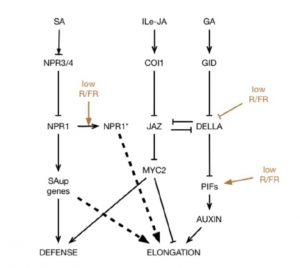Salicylic Acid and Shade Avoidance
 In response to shading, plants undergo a suite of developmental and physiological responses known as shade avoidance. In agricultural settings, dense planting can cause shade avoidance responses, thereby reducing yields due to changes in carbon allocation that favor stem elongation over seed, fruit, or tuber production. It is important, therefore, to understand shade avoidance signaling pathways throughout the lifespan of the plant. Most previous studies concerning shade avoidance have focused on hypocotyl elongation in young seedlings. However, given that shade avoidance responses are observed in many different organs throughout the plant life cycle, it is important to examine whether there are different signaling pathways operating in different organs or life stages. Nozue et al. (10.1104/pp.18.00920) have measured transcriptome changes in response to shade in wild type and twelve Arabidopsis (Arabidopsis thaliana) mutants. Their efforts revealed several mutants with altered salicylic acid (SA) levels or signaling that are defective in petiole shade avoidance, demonstrating a role for SA pathways components in shade avoidance by petioles. The effect of these mutations on shade avoidance was specific to petiole elongation; neither hypocotyl nor flowering time responses were altered. Although these results indicate that SA pathway genes are key components of petiole shade avoidance, the role of SA signaling pathways in petiolar shade responses is not simple: the authors report that shade treatment did not change SA levels.
In response to shading, plants undergo a suite of developmental and physiological responses known as shade avoidance. In agricultural settings, dense planting can cause shade avoidance responses, thereby reducing yields due to changes in carbon allocation that favor stem elongation over seed, fruit, or tuber production. It is important, therefore, to understand shade avoidance signaling pathways throughout the lifespan of the plant. Most previous studies concerning shade avoidance have focused on hypocotyl elongation in young seedlings. However, given that shade avoidance responses are observed in many different organs throughout the plant life cycle, it is important to examine whether there are different signaling pathways operating in different organs or life stages. Nozue et al. (10.1104/pp.18.00920) have measured transcriptome changes in response to shade in wild type and twelve Arabidopsis (Arabidopsis thaliana) mutants. Their efforts revealed several mutants with altered salicylic acid (SA) levels or signaling that are defective in petiole shade avoidance, demonstrating a role for SA pathways components in shade avoidance by petioles. The effect of these mutations on shade avoidance was specific to petiole elongation; neither hypocotyl nor flowering time responses were altered. Although these results indicate that SA pathway genes are key components of petiole shade avoidance, the role of SA signaling pathways in petiolar shade responses is not simple: the authors report that shade treatment did not change SA levels.


